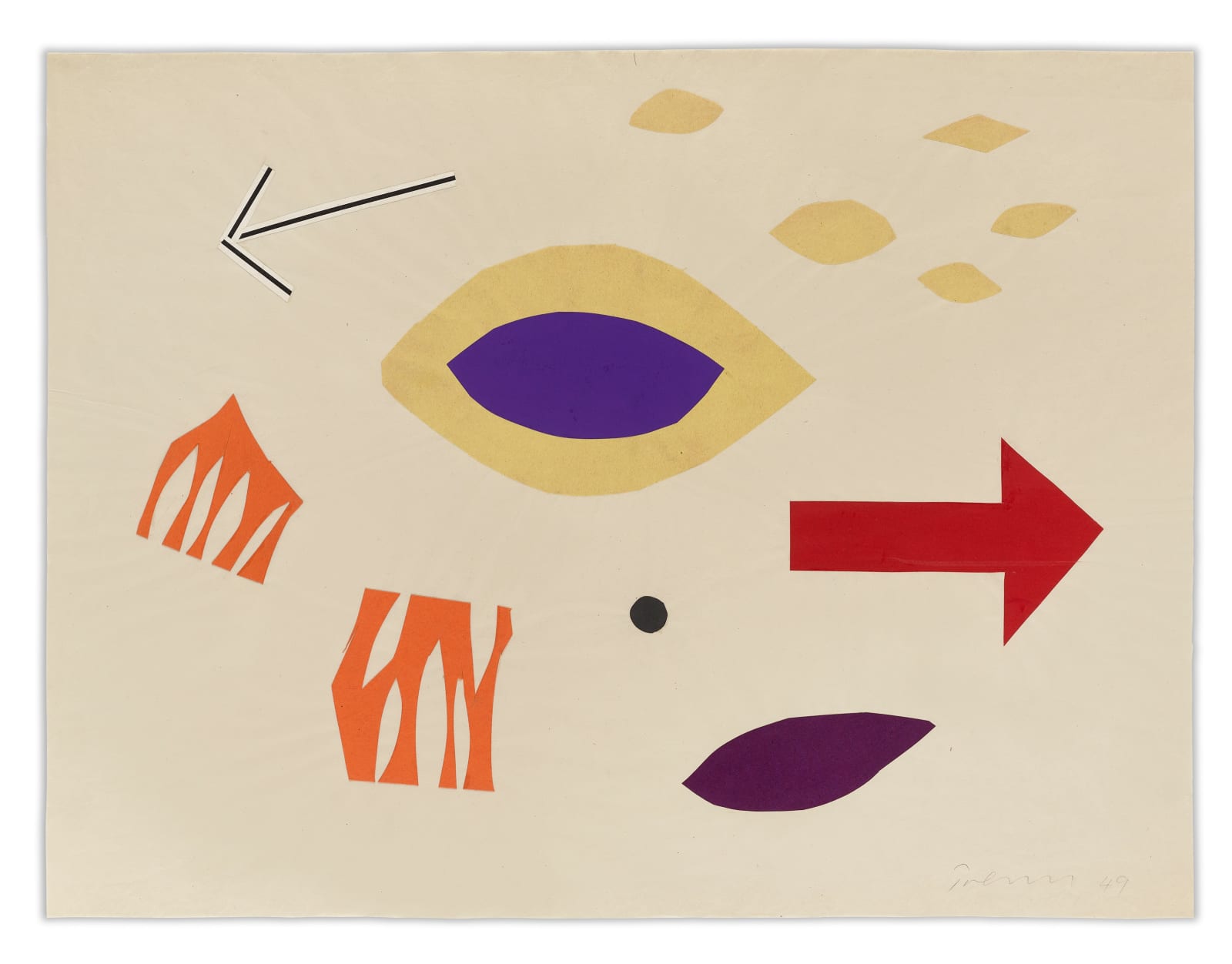William Turnbull 1922-2012
39.4 x 52.4 cm
Turnbull always relished reversals in nature that provided dramatic emphasis. ‘We can also look up at the fish and down at the birds’ as he said in 1956. His interest in what was above and what lay below was connected to his recent experiences as a pilot. The organisms that provided inspiration for this work, as the title suggests, were fish and other forms of sea life, such as algae, molluscs and jellyfish. In the aquarium the power of gravity is suspended and forms are free to float. Looking back later, Turnbull summarised his preoccupations at this time:
'I was very involved in the random movement of pin-ball machines, billiards (which I played a lot) and ball games of this sort; and the predictable movement of machines (in the Science Museum). Movements in different planes at different speeds. I loved aquariums. Fish in tanks hanging in space and moving in shoals. The movement of lobsters. I became quite expert with a Diablo. I was obsessed with things in a state of balance.'2
‘I was fascinated with things moving and touching and perceptually convinced of energy as creation. The movement of insects, fish and plants seemed to be a making and breaking of contacts. Like a marvellous electrical system. The word most in my mind was “contiguity”. Perhaps it doesn’t express what I mean but it acted as a mnemonic aid. I wanted to make sculpture that would express implication of movement (not describe it), ambiguity of content, and simplicity (lack of interesting detail separate from the whole).’3
A multi-disciplinary artist, Turnbull would typically explore similar concerns through different media. The reduction of organisms to basic forms, and the representation of movement and direction through elemental means that characterise the Aquarium collages relate directly to sculptures, paintings and works on paper that he made in the same year. One, Hanging Sculpture 1949 (Coll. Tate, London) is a mobile suspended sculpture in which the forms of fish are rendered schematically as arrows hanging at different heights; another is a static bronze sculpture entitled Aquarium 1949 (Coll. National Galleries Scotland, Edinburgh) in which the arrows representing the fish rise up at different heights from an integral base. Turnbull was still exploring similar themes some three years later, in works such as Aquarium, 1952, where a shoal of fish is portrayed by way of a plethora of short, expressive multi-coloured brush marks.
In 1950 Turnbull showed a selection of his work from Paris at the Hanover Gallery in a joint show with Eduardo Paolozzi and Kenneth King. Opened by Erica Brausen in 1947, the Hanover Gallery became one of the most notable galleries in London, dealing in 19th and 20th century masters and contemporary British and foreign artists, including Francis Bacon, Lucian Freud and Alberto Giacometti. A series of photographs taken by Nigel Henderson which document the installation of this formative exhibition are a fascinating and useful record. They show the narrow space on the top floor of the gallery which Turnbull was given to display his work. In some images we see the artist crouching down, experimenting with placing a number of his the plasters directly on the floor, while in others we see their final arrangement, on three-legged modelling stands. In one particularly dark photograph, which is difficult to decipher, there also appear to be four paintings or works on paper, including an Aquarium collage hung on the surrounding walls.
Few of Turnbull’s works from the 1940s have survived, many were destroyed either by the artist himself or as the result of having been left behind in storage in Paris after he returned to London at the end of 1950. This collage is therefore an extremely rare example from the period and as such it was selected to be included in Offer Waterman’s recent retrospective of Turnbull’s work to commemorate the centenary of the artist’s birth.
1 William Turnbull, in ‘Retrospective Statements,’ The Independent Group: Post War Britain and the Aesthetics of Plenty, David Robbins (ed.), Cambridge, Mass, London, MIT Press, 1990, p195
2 William Turnbull cited in Richard Morphet, ‘Commentary,’ William Turnbull, Sculpture and Painting, exh. cat., Tate Gallery, London, 1973, p26
3 The Tate Gallery Report, London 1967, Ibid
Provenance
Estate of the ArtistExhibitions
London, Offer Waterman at No.9 Cork Street, William Turnbull: Centenary Retrospective, 29 June – 20 July 2022, cat no.2, illus colour p30
Literature
Jon Wood (ed.), William Turnbull: International Modern Artist, Lund Humphries, London, 2022, p.36, illus colour
